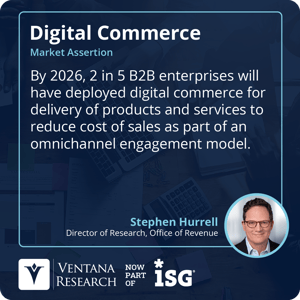As a business application tech analyst, I tend to focus more on B2B than B2C and the differences between the two. So, when it comes to digital commerce, I am interested in the differences from a process or functional point of view and therefore the potential digital commerce application or platform needs required to support B2B commerce. With more B2B enterprises looking to provide access in a timely manner and when and where the customer chooses, digital commerce is a growing part of the overall customer experience. It is safe to say that in B2B commerce, the Amazon effect also applies, in that customers expect a similar level of frictionless automation, immediacy and simplicity in operation. But, as I will discuss, there are significant differences between B2B and B2C around individuality in pricing, more complex product sets and payment terms.
In fact, we assert that by 2026, 2 in 5 B2B enterprises will have deployed digital commerce for delivery of products and services to reduce cost of sales as part of an omnichannel engagement model.
engagement model.
As mentioned, there are several key differences between B2B and B2C commerce: in B2B, prices are individually negotiated, products and service combinations are often conditional, and payment is typically made after the actual purchase. Because of this, the digital storefront aspect of many digital commerce solutions is less important to B2B enterprises than the ability to support configure, price and quote (CPQ) capabilities, as well as integration with fulfillment, delivery and buyer access to previous purchase history and assets.
As has been documented elsewhere, enterprises of varied sizes across many verticals and industries have adopted recurring revenue models such as subscription and usage pricing. Coupled with individually priced contracts that can include tiered and other threshold-based models, B2B pricing tends to be more complex than B2C and often requires evaluation or rating at a set periodic billing event, that considers accumulated transactions and volume. So, the eventual rate and price are not known until some point after any transaction happens, unlike with B2C commerce, where the price is known, and payment is typically made when placing the order. Likewise, the actual choice of products and services is often also more complex, for example, where initial selections lead to conditional constraints as to the availability of dependent products and services. If subscription-based products and services are part of an overall physical product offering, integration with subscription management and billing systems will ensure that fulfillment and entitlement management are synchronized as well as unified invoicing crossing potentially many internal product and business units.
In addition to the steps related to the complexity of configuration and pricing, there are typically additional tasks required as part of the initial sale. These relate to producing a quote and subsequent contract negotiations that are used to establish terms for such items as the remediation process for issues and disputes, obligations for both parties as well as agreed pricing, delivery and fulfillment, and term duration. With the capability of current technology, these processes are conducted by a buyer and a seller through conversation, email, or some other form of communication. However, subsequent changes to the initial order, now governed by a contract such as a Master Service Agreement (MSA), can be self-service using digital commerce capabilities. However, given the need for CPQ-type capabilities, and not having to make payment at the time of placing the order, the typical B2C digital commerce storefront is not appropriate. This also has implications for the type and context of product information that needs to be made visible as part of the online ordering process. Whereas a typical B2C commerce site allows a customer to choose from available products, B2B typically relies on a configuration and matching process and may involve 3D renderings of technical products as well as conditional logic to ensure that combinations are valid. Likewise, computing the price for any given configuration may require a separate quoting process. Although the aim should be to automate the quoting process, a manual “sign off” may be required. And this information needs to be synchronized across all buying channels, as the journey may start and end at a digital commerce site, but in between may have person-to-person touchpoints.
In fact, B2B digital commerce must be thought of in terms of the entirety of the customer experience as this is less transactional and more of a continuum. When thinking of enabling digital commerce as part of an overall customer engagement model, it is important to think of any potential digital commerce capability in the context of the client life cycle and not just as an alternate buying channel for clients. The applicability of digital commerce will depend not only on the sales motion deployed, but also where in the customer life cycle the activity is expected to take place. So, unlike the standard digital commerce retail storefront more typically seen in a B2C engagement, for B2B, the desire to place an order online may well be in the context of a renewal conversation or as a follow on upsell or cross-sell under the terms of a negotiated MSA or contract.
Software providers in the digital commerce space are recognizing this by creating consumable service components that can be deployed within the context of the overall digital customer experience, whether it is an online support portal, billing inquiry application or a product information site and CPQ site.
For enterprises wanting to incorporate digital commerce into their overall customer experience, or for those that have tested the waters and want to move to the next level, it is vital to understand at which points in the life cycle a customer is likely to want to place a digital order. This, along with the types of products and services offered and the extent to which the buyer-side process can be automated or digitized, will determine the capabilities needed from a software provider and the degree to which componential services can be incorporated into an overall digital customer experience. It is important that this understanding forms the foundational requirements when investigating potential software provider’s offerings to meet those customer expectations of frictionless automation, immediacy, and simplicity in operation.
Regards,
Stephen Hurrell

 engagement model.
engagement model.








